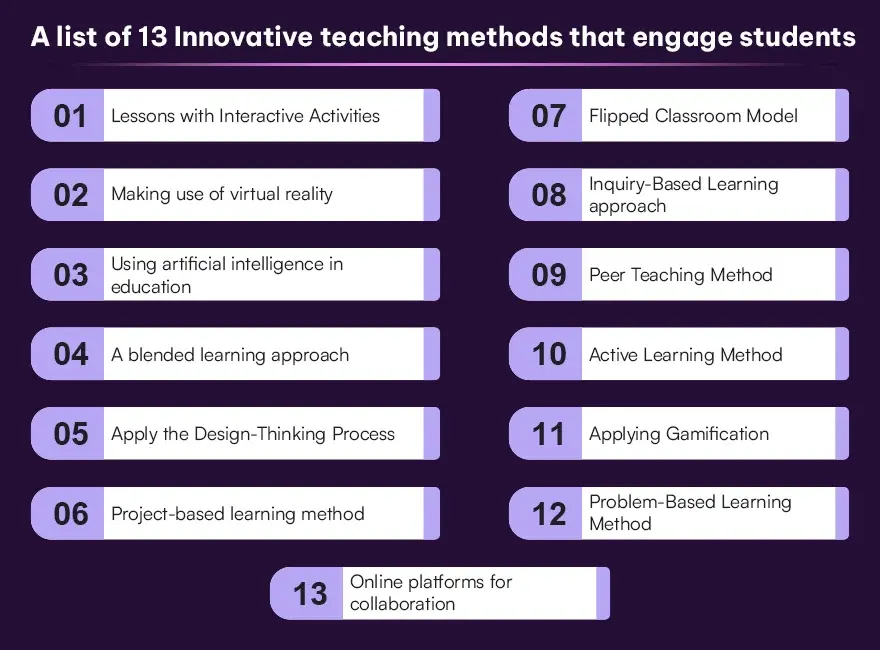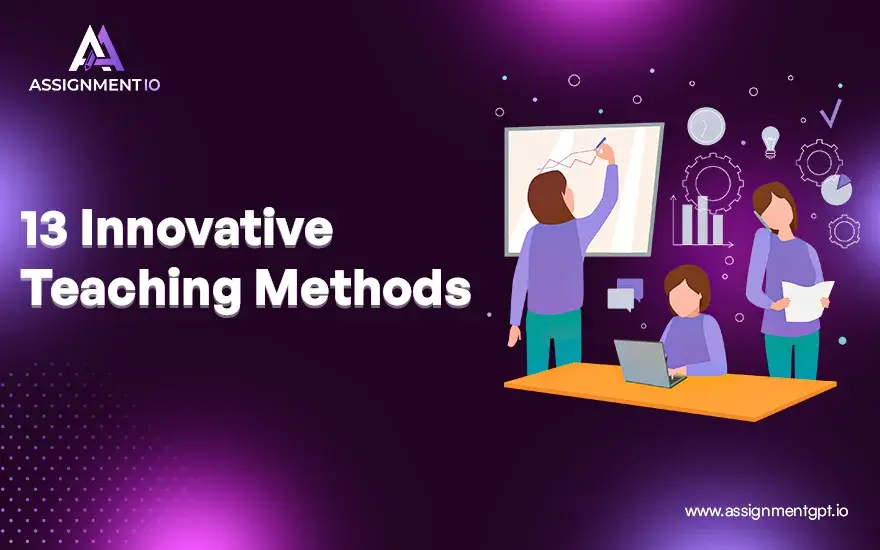13 Innovative Teaching Methods To Engage Students In Learning

Vikas Kukadiya
With the ever-changing nature of education, it is the teacher's duty not only to transfer knowledge but to meaningfully connect experiences in their lives with students. Innovative teaching has evolved from lectures to excitingly sparking the students' imagination, creativity, and thinking skills in class.
Today's learners need different types of teaching approaches to use technology, collaborate, and have hands-on experiments. This article will discuss 13 innovative teaching methods that can change the nature of the classroom into an effective learning environment. Each method is presented with real examples to provide a clear understanding of its practical application and effectiveness.
Quick Summary
This blog shares 13 new teaching methods, from interactive activities and virtual reality to artificial intelligence and gamification. Each strategy is designed to enhance student engagement and foster curiosity with a platform that supports various learning styles. Innovative teaching techniques allow educators to create an energetic environment with motivated learning, collaboration, and critical thinking.
What are Teaching Methods?
ching methods are modes or techniques undertaken by teachers to facilitate knowledge and learning. Conventional teaching methods include lecturing, note-taking, and memorizing. Innovation in teaching practices involves skills that basically range from being more interactive with participation from the students and relating the classroom theory with practical life experience. These methods form the foundation of tailoring education to fit diverse needs and abilities, helping a student connect theory with real-life skills.
Importance of Teaching Methods
The type of teaching method directly influences the participation level of the students, and therefore, their achievements. Traditional methods are predominantly based on passive learning on the part of the learners, where they receive knowledge without taking an active approach. Innovative methods of teaching emphasize making the learning process more interactive so that it overlaps most forms of learning. When educators apply innovative teaching approaches, they provide for deeper learning, better problem-solving capacities, and more interest in studying among digital-age students who expect interactive and multimedia content.
Two Main Types of Teaching Methods
There are two broad types of teaching methods: traditional methods and new methods.
1. Traditional Methods of Teaching:
Mainly Teacher-Centered, Organized, and heavily reliant on lecturing, rote memorization, and note-taking. Traditional methods offer a fundamental framework for learning the central material but do not necessarily attempt to meet individual students' specific learning needs nor encourage student engagement.
2. The modern approach:
This is more considered interaction-based teaching with hands-on activities, collaborative projects, and the use of technology. With gamification, project-based learning, and blended learning in innovative teaching strategies, the student develops knowledge backed by thinking, creativity, and collaboration.
Also read this article : Best Online Homework Help Websites for Students
A List of 13 New Ways to Engage Students in Learning
Explore new ways to engage students in learning, including gamified lessons, flipped classrooms, project-based activities, interactive storytelling, and real-world problem-solving. Integrate technology, virtual field trips, peer collaboration, and creative challenges to inspire active participation and deep understanding.

1. Interactive Lessons
An interactive lesson is a very engaging method where the students are directly involved in what the teacher teaches. It enables them to remember certain things better by participating actively. This may include live quizzes or online polls, among others.
- Example: The teacher may use Kahoot or Poll Everywhere as an online source for live quizzes. Students may answer questions using their devices, thus making the class lively and competitive.
2. Using Virtual Reality
Virtual Reality allows learning to explore many contexts and experiences through the use of immersive technologies from the comfort of a student's classroom. VR can make abstract concepts more concrete, hence more understandable and engaging.
- Example: As students learn geography, they might take a Google Expeditions virtual tour across the Amazon rainforest for memorable, immersive learning about biodiversity.
3. Artificial Intelligence in Education
AI tools use personalization for learning purposes, altering the content according to the individual learning pace and style of each student. The fine-tuned method can enhance individual performance and keep students engaged.
- Example: Using AI-powered tools such as AssignmentGPT IO, receiving personalized assignment feedback enables students to understand their mistakes and improve through targeted exercises.
4. Blended Learning Approach
Blended learning allows students to learn online at home while working on projects in class. This method of learning has flexibility but still allows deeper classroom engagement.
- Example: In a flipped classroom, the students may watch science videos at home while doing experiments or having group discussions in class.
5. Application of Design Thinking Process
The design thinking method of instructing students encourages them to solve problems through brainstorming, prototyping, and testing, which encourages hands-on iterative learning.
- Example: A group of social studies students could brainstorm an idea that solves the issue of littering in public places and design campaigns that promote awareness, critical thinking, and application to real life.
6. Project-Based Learning (PBL) Procedure
Project-based learning is based on real-world issues. Students develop research, collaboration, and problem-solving skills all the time through work on extended projects.
- Example: History class can be working on project recreations of parts of ancient civilizations, such as building models of famous historical structures in order to make students more involved in history.
Also read : Most effective strategies to motivate students
7. Flipped Classroom Model
In the flipped classroom, new material will be introduced to learners at home, while class time will be devoted to deepening their understanding through discussions and practical activities.
- Example: In language class, students may watch videos on grammar at home and then use class time for speaking exercises that give them more opportunities to practice and interact.
8. Inquiry-Based Learning approach
The inquiry-based learning approach encourages the student to be responsible for his or her learning since it mainly puts to focus open-ended questions and exploration to incite curiosity and investigation.
- Example: A science class might begin with the question, "How does pollution affect marine life?" Students do research, experiment, and present their findings, thus integrating the development of critical thinking and research skills.
9. Peer Teaching Method
Peer teaching is one of the ways through which students increase their mastery of knowledge as they teach other students, thereby making understanding easy and learning a more collaborative process.
- Example: In a math class, a student who has mastered a concept like fractions can explain it to his classmates; it boosts his confidence, and for sure, he will reinforce his understanding of the subject as well.
10. Active Learning Method
Active learning pulls the focus away from passive listening and towards activities that encourage participation and direct experience, which in turn create understanding and retention.
- Example: In a business class, students may role-play a negotiation situation, which will help them practice both communication and critical thinking in a simulated, real-world context.
11. Applying Gamification
Gamification introduces elements of game into lessons to make it fun and motivate students to achieve learning goals.
- Example: When the class is engaged in Classcraft, the students earn points to complete a task or answer a question correctly, levelled up and unlocking rewards that slowly come their way.
12. Problem-Based Learning Method
Problem-based learning focuses attention on real life problems and challenges learners to exercise critical thinking and collaboration in research to solve the issues and, therefore, relate the theory to practice.
- Example: In an environmental science class, students can take up the challenge of scarce water by researching means of saving water and coming up with sustainable solutions.
13. Online Platforms for Collaboration
Online collaborative platforms endorse teamwork and digital literacy among students as they work together on shared projects and assignments even where members cannot be in the same physical space.
- Example: Students can work as a group on a shared Google Classroom or AssignmentGPT IO document to brainstorm ideas and feedback from the teacher in real-time, reducing the complexity of the work and communication between members.
Conclusion
New teaching methods and techniques can change the whole scenario of the classroom, making it an exciting place where students can learn and experiment as they grow. Techniques such as VR, AI, gamification, and project-based learning keep students engaged actively while developing broader critical skills beyond academics. AssignmentGPT IO also supports educators with the additional value offered by AI-based resources, inquiry-based learning tools, and collaborative platforms that are so valuable to modern education today.
The highly innovative teaching approaches available can be used by educators as they seek to meet the needs of today's learners and produce an environment for learning that is not only engaging and inclusive but also effective.
FAQs
1. What are some innovative, effective teaching techniques?
Project-based learning, inquiry-based learning, peer teaching, and collaborative online tools increase the engagement level of students.
2. Why is innovation in teaching important?
It makes the learning process interactive, increases the interest level among learners for whatever they learn, and inculcates within students all those critical skills such as problem-solving skills, creativity, and teamwork, making the learning process have an impact.
3. How does virtual reality help in education?
We help foster an immersive environment that allows the exploration of new environments and concepts to enable the children to learn in a more tangible way, making the lessons engaging and memorable.
4. How does AssignmentGPT IO promote innovative learning?
AssignmentGPT IO offers AI-based interactive tools for learning, inquiry-based activities, and platforms for online collaborative learning to empower students and instructors alike to take the lead in the learning process.
5. What are some possible types of teaching methods?
Some of the teaching methods include lectures; other more innovative approaches include gamification, blended learning, active learning, and problem-based learning.
